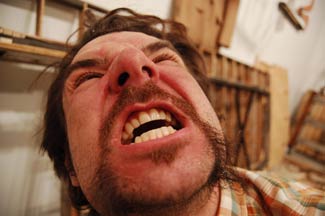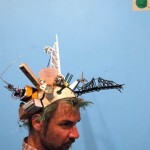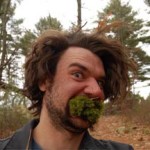By CHRISTIAN HOLLAND
Jon Taylor, an artist of New Bedford, Massachusetts, will, on occasion, put moss into his mouth. It’s true; there are pictures to prove it. He will also make expressions like those Andrew W.K. makes when photographed, but it’s doubtful that Jon copied Andrew, as Jon is several years older, giving him much more time on this earth to conjure up such visagial misconfigurations (1).
Jon believes the most mundane and widely accepted aspects of our lives are the ones that need the most scrutiny. The basic practices which make up our daily routines are mere analogs of the survival techniques of the beasts we evolved from; “it’s really rich stuff,” he says, “a lot of it goes back to basic human nature that’s been perverted somehow. Our basic needs haven’t changed over the past how-many-millennia, it’s just how we get to those ends that has changed drastically in a very short period.” It is that very how that Jon examines, turns inside-out, and ridicules in order to aid the scrutiny which Jon hopes to incite in his audience and participants.
Last spring, Jon had a residency at the Berwick Research Institute where he “embark[ed]on a series of social experiments that... explore[d]the commodification of the human body as related to modern man's treatment of the landscape.” Bonnie Bastien, AIR’s curator informed me that, “In general, Jon is selling parts of his head to you or anyone interested for development. He has shaved his head (clear-cut the land) leaving only a fringe around the perimeter.” The experiment was called Head Acres.
After shaving his head, in order to enable construction on his cranium, he created a molded skull-cap to which all building foundations could be securely attached with a high-tech, medical plastic that doctors use to make splints for broken bones—Jon discovered the material after breaking his hand last year. The fringe of hair Jon left around the perimeter of cap was dyed green and represented the “green comb-over:” the thin layer of trees that almost ubiquitously divides the highways and major roadways of America from the land the roads border (It may be no surprise that he grew up in New Jersey right next to the Parkway and Turnpike). Jon evenly divided the skull-cap into approximately one-inch square spaces, with roads both connecting and partially demarcating them; after each lot was drawn, the cap resembled a phrenology diagram.
Jon put each lot up for lease, the length of which would run through his residency at the Berwick and set up a business under the name of Cranial Development Corporation. The rent would be $10, though a few premium sites would be placed on EBay. Jon had no limitation for the size and scope of any structures being built on his head, he only supplied prospective builders with the caveat that they would be riding around on his skull everywhere he went, unless he was bathing or sleeping. Some of space was preserved as “open space” where “developers” could not build and Jon actually cut a hole in this area of the skull-cap so his hair could grow out. Anyone purchasing land would also have a right to create their own open spaces; ironically, however, if too many people created open space, the skull cap would fail, falling apart and taking all its development with it. To further his theme of land use, Jon, a non-packagitarian who owns a Volvo that runs on used vegetable oil, designed Head Acres around ideals of sustainability. He reused his hair to make paint brushes, which were auctioned at his AIR residency closing event. Shortly after the property went to market, his head became occupied by, but not limited to: a live plant, missile silo, draw bridge, replica of the Burj al Arab Hotel in Dubai, and a library replete with actual, though miniature, book.
I met Jon at the Middle East Club one evening back in June after he was well into his residency and the plots of land on his head was beginning to look like a community. He drank two beers and I drank two cokes and ate pureed garlic with French fries. Our server came by our table and earnestly complimented his “hat” while he and I chatted. This interaction, though not surprising considering the burgeoning society on Jon’s head, is what he was hoping for. He views the “spectacle factor” of such an accessory as an asset to the work. His gregariousness needs no assistance from the relatively outlandish headwear, but his sense of humor seems to compel such qualities in his work. Consider this statement from Jon’s Berwick AIR Blog: “So at some point, I started thinking of my head as a landscape. Maybe it was how my thick and messy locks resembled a wild forest or how my dandruff looked like litter caught in roadside grasses, but the idea stuck with me.” The nonchalance with which he discusses his hygienic foibles and his visual analogies are inherently humorous. He believes that “humor also makes an artwork accessible to people in that it is generally non-threatening, and is a good starting point for more intense dialogue.”
And indeed, Head Acres’ immediate success is just that. The work Jon creates facilitates an understanding of his issues and allows participants other ways in which to comprehend those issues. Through his lifestyle, he is thoroughly engaged in the issues and ideas his work addresses as an activist but, despite the political coherence of his work, he attempts to be open-ended and allow his work to be understood on different levels. Whether the viewer (or participant) even realizes it, they enter the body/land dialogue which foregrounds Head Acres just by acknowledging the presence of a globular model on Jon’s skull. He contends that the same thought process for beauty is applied to land, we just don’t realize it, and “hope[s]to personalize our treatment of and attitude towards the land itself.”
(1) We can’t say for sure whether either of them was inspired by Dick Cheney or any professional wrestler.
- The artist Jon Taylor in a recognizable pose.
- Head Acres with Jon Taylor.
- Jon Taylor with moss in his mouth.
Jon Taylor was in residence at the Berwick this past spring. He work will be exhibited this fall at the New Bedford Art Museum.
All images are courtesy of the artist and the Berwick Research Institute.






